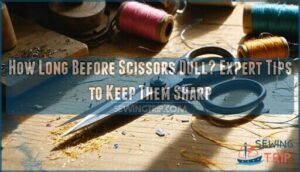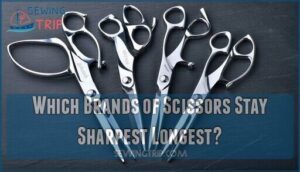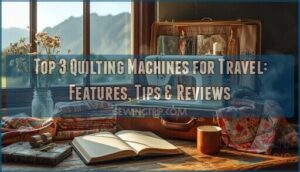This site is supported by our readers. We may earn a commission, at no cost to you, if you purchase through links.

If you’re a heavy user tackling cardboard, fabric, or tough materials daily, expect noticeable dulling within 3-6 months.
Casual users who stick to paper and light tasks can enjoy sharp blades for 1-2 years or longer.
Quality matters too—cheap scissors lose their edge faster than premium brands.
You’ll know they’re dulling when they start bending paper instead of cutting cleanly, or when fabric gets caught between the blades.
The good news? Simple maintenance tricks can extend their lifespan substantially.
Table Of Contents
- Key Takeaways
- What Are Fabric Scissors?
- When Are Scissors Considered “Dull”?
- How Long Do Scissors Generally Last?
- Can You Sharpen Scissors Yourself?
- Which Brands of Scissors Stay Sharpest Longest?
- How to Sharpen Scissors With a Sharpening Stone
- How to Sharpen Scissors With a Rotary Tool
- How to Sharpen Scissors With Sandpaper or Aluminum Foil
- Frequently Asked Questions (FAQs)
- Conclusion
Key Takeaways
- You’ll see scissors dull in 3-6 months with heavy daily use on tough materials like cardboard and fabric, while casual paper-cutting can keep them sharp for 1-2 years or longer.
- You can tell your scissors are dull when they bend paper instead of cutting cleanly, create frayed edges on fabric, or fail the marker test where the line remains unbroken after cutting through it.
- You don’t need professional services to restore sharpness—simple DIY methods like cutting through aluminum foil, using sandpaper, or working with a sharpening stone can bring dull blades back to life.
- Your scissors will stay sharp longer if you invest in quality brands like Gingher or Fiskars, store them in protective cases, and avoid cutting abrasive materials like tape, plastic, or cardboard that accelerate dulling.
What Are Fabric Scissors?
Fabric scissors are precision instruments designed specifically for cutting textiles.
They feature a steep blade angle that slices through fabric layers cleanly without fraying edges.
The handle design typically includes bent handles for comfortable fabric cutting at table level.
Made from high-quality steel grades, these scissors maintain their scissor sharpness longer when used for their intended use.
Their specialized scissor weight provides control during intricate cuts, making them essential tools for preventing premature scissors dullness in fabric projects.
When Are Scissors Considered “Dull”?
Several telltale signs reveal when your scissors have lost their edge.
When your scissors start crushing instead of cutting, they’re crying out for attention.
You’ll notice cutting performance decline as blades struggle through fabric, requiring increased force to complete cuts.
Instead of clean lines, you’ll see frayed edges and serrated cuts that damage your material.
The reliable marker test offers definitive proof—draw a line on paper, then cut through it.
If the marker line remains unbroken after cutting, your scissors suffer from blade sharpness loss.
These scissors dullness indicators signal it’s time for maintenance to restore cutting precision.
How Long Do Scissors Generally Last?
Your scissor lifespan depends on several key factors that determine how long they’ll stay sharp. Professional-grade scissors can last 5-20 years, while household scissors typically need replacing every 3-5 years.
Here’s what affects scissor durability:
- Material Impact – High-carbon steel maintains sharpness longer than cheaper alternatives
- Usage Frequency – Daily use accelerates dullness compared to occasional cutting
- Maintenance Matters – Regular cleaning and annual sharpening extend lifespan substantially
- Storage Conditions – Protective cases prevent edge damage and premature wear
The cutting surface you use also influences scissor sharpness retention over time. To keep scissors in prime condition, consider regular scissor cleaning.
Can You Sharpen Scissors Yourself?
You don’t need to toss your scissors the moment they struggle to cut cleanly through fabric—several DIY sharpening methods can restore their cutting edge using common household items.
Don’t throw away struggling scissors—simple household items can bring those dull blades back to life.
Simple techniques like cutting through aluminum foil, using sandpaper, or working with an abrasive stone can bring dull blades back to life, saving you money and extending your scissors’ lifespan substantially.
Aluminum Foil
Your kitchen drawer holds a surprisingly effective sharpening solution.
Aluminum foil can restore dull scissors through a simple cutting technique.
Fold several sheets of foil to create thickness, then make 10-15 cuts through the layers.
This process realigns blade edges while removing built-up debris.
Foil Sharpening Effectiveness works best on moderately dull household scissors, though Foil Gauge Matters—thicker foil provides better results.
While Foil vs Alternatives shows this method isn’t as precise as professional tools, it’s perfect for quick touch-ups between major sharpenings.
For a more thorough approach, consider using a whetstone.
Abrasive Stone
You’ll find sharpening stones deliver professional-grade results for scissor sharpening. These abrasive materials require careful angle precision—maintain a 20-degree angle while drawing each blade across the stone material.
Lubrication use with water or oil prevents overheating during the process. You can find a suitable stone for sharpening online.
- Choose medium stone grit (400-800) for ideal blade restoration
- Maintain consistent 20-degree angle throughout each sharpening stroke
- Apply light water lubrication to prevent metal overheating damage
- Complete burr removal by gently stroking blade’s flat side
Sandpaper
Around your workshop, sandpaper becomes your trusty ally for combating scissor dullness. Medium-grit sandpaper (150-200 grit) works perfectly for this sandpaper technique. Fold the sandpaper with the abrasive side facing outward, then make 8-12 careful cuts through it. This surface preparation method realigns blade edges while removing minor imperfections.
You can find various sandpaper sharpening products online.
Here’s what makes sandpaper sharpening effective:
- Cost-effective solution – Uses materials you likely already have
- Gentle restoration – Removes minimal metal compared to aggressive methods
- Versatile grit options – Different sandpaper grit levels suit various dullness levels
- No special tools required – Simple sharpening techniques anyone can master
- Quick results – Restores cutting ability in minutes
- Multiple sandpaper alternatives – Various grits provide different sharpening angles
Which Brands of Scissors Stay Sharpest Longest?
You’ll find that certain brands consistently outperform others in terms of maintaining sharp edges over time, with high-carbon steel construction and precision manufacturing making all the difference.
Premium brands like Gingher, Fiskars, SINGER, and IBayam have earned their reputations by using superior materials and forging techniques that resist dulling far longer than budget alternatives.
Gingher Knife Edge Dressmaker’s Shears
Professional sewers swear by Gingher’s knife-edge dressmaker’s shears for their exceptional steel quality and forged blade benefits.
These scissors maintain razor-sharp precision through thousands of cuts, making them worth the investment.
| Feature | Benefit |
|---|---|
| High-carbon steel construction | Extended scissor lifespan |
| Ideal blade edge angle | Clean cuts on delicate fabrics |
| Ergonomic handle design | Reduced hand fatigue |
| Professional forging process | Superior sharpness retention |
Their handle ergonomics reduce strain during extended cutting sessions, providing superior sharpness retention and making them a valuable tool for professional use.
Fiskars Razor-Edge Softgrip Scissors
While Gingher scissors excel in professional settings, Fiskars Razor-Edge Softgrip Scissors offer exceptional value for home sewists who want professional-grade performance without breaking the bank.
These scissors combine Razor-Edge Performance with innovative Softgrip Ergonomics, making extended cutting sessions comfortable and precise. The Material Composition features high-carbon steel blades that resist dullness substantially longer than standard scissors.
You’ll notice the difference immediately – clean cuts through multiple fabric layers without fraying or snagging. The razor-edge design maintains its sharpness for months of regular use.
Fiskars Durability shines through consistent performance. With proper scissor maintenance, these scissors can handle your heaviest projects while maintaining their edge. When dullness eventually occurs, basic scissor sharpening techniques can restore their cutting power.
Best Uses include:
- Heavy fabrics like denim and canvas
- Precision quilting and appliqué work
- Multi-layer cutting projects
- Extended crafting sessions requiring comfort
Your scissor lifespan extends considerably with Fiskars’ engineering excellence.
SINGER ProSeries Bent Sewing Scissors
You’ll appreciate SINGER ProSeries Bent Sewing Scissors for their exceptional ergonomic benefits and precision cutting.
The bent design reduces hand strain while delivering clean, accurate cuts through multiple fabric layers.
These scissors maintain their sharpness longer than standard models, though regular scissor maintenance and occasional sharpening scissors sessions will keep them performing at peak levels for years of reliable sewing precision.
IBayam 8 Multipurpose Scissors
Choosing the right multipurpose scissors can make all the difference in your cutting projects.
IBayam 8 Multipurpose Scissors deliver impressive cutting performance that stands the test of time.
Their ergonomic design reduces hand fatigue during extended use, while superior material quality guarantees consistent sharpness retention.
These versatile tools excel in multiple applications:
- Fabric cutting – Clean cuts through various textile weights
- Craft projects – Precise trimming for paper and cardboard
- Kitchen tasks – Food preparation and packaging
- Office work – Document handling and general cutting needs
IBayam durability shines through their high-carbon steel construction, which maintains sharp edges longer than standard scissors.
When dullness eventually occurs, proper scissor maintenance becomes vital.
Regular scissor sharpening using appropriate techniques can extend their lifespan substantially.
Their alternative uses make them invaluable for households and workspaces alike, proving that quality multipurpose scissors are worth the investment.
How to Sharpen Scissors With a Sharpening Stone
You can transform dull scissors into precision cutting tools using a sharpening stone. This time-tested method requires patience but delivers professional results.
Here’s your step-by-step sharpening process:
- Stone Angle: Position the beveled edge at 20-25 degrees against the coarse stone surface
- Pressure Control: Apply gentle, consistent pressure while making 10-15 strokes per blade
- Burr Removal: Switch to fine grit and lightly draw the inner blade edge across
- Stone Types: Use combination stones with coarse and fine surfaces for best results
- Lubrication Needed: Add water or oil to prevent metal filings from clogging stone pores
How to Sharpen Scissors With a Rotary Tool
When rotary tools come into play, scissor sharpening becomes surprisingly manageable. These versatile tools offer precise control for restoring your blades’ cutting edge.
- Select appropriate rotary tool types and bit grit selection – Choose fine-grit grinding stones for superior results
- Master angle and pressure techniques – Maintain consistent blade positioning against the abrasive surface
- Follow essential safety precautions – Wear protective gear and keep steady hands throughout the process
- Complete with polishing after sharpening – Switch to finer bits for that professional finish
This DIY approach delivers professional-grade results. Regular maintenance helps extend scissor lifespan considerably.
How to Sharpen Scissors With Sandpaper or Aluminum Foil
When professional tools aren’t available, everyday materials can restore your scissors’ cutting edge. Both sandpaper and aluminum foil offer accessible sharpening solutions that work surprisingly well.
Foil Sharpening Tips and sandpaper grit choice matter for maximum results:
- Choose 150-200 grit sandpaper for balanced abrasiveness
- Cut through aluminum foil 10-15 times with smooth strokes
- Maintain consistent cutting technique angles throughout the process
- Observe safety precautions by wearing protective gloves always
- Consider alternative materials like fine steel wool sparingly
These scissor sharpening methods restore basic sharpness effectively. Regular lubrication helps guarantee smooth scissor movement.
Frequently Asked Questions (FAQs)
What materials make scissors dull fastest?
Like a knight’s sword meeting stone, your scissors face their greatest enemies in paper, cardboard, plastic, and duct tape.
These abrasive materials act like sandpaper, rapidly dulling blades that should cut only fabric.
How often should scissors be professionally sharpened?
You should have your scissors professionally sharpened every 6-12 months with moderate use.
Or when they start struggling through fabric, heavy users might need sharpening every 3-4 months to maintain peak performance.
Does storage method affect scissor sharpness?
Yes, your storage method directly impacts scissor sharpness.
Protective cases prevent blade contact and edge damage, while proper storage reduces exposure to humidity, dust, and temperature fluctuations that accelerate dulling and corrosion.
Can environmental conditions accelerate scissor dulling?
Environmental factors definitely impact your scissors’ sharpness.
Humidity accelerates metal oxidation, salt exposure increases corrosion risk, and temperature fluctuations affect blade integrity.
Dust and debris also contribute to faster wear, making proper storage essential.
What cutting surfaces damage scissor blades most?
Hard surfaces like ceramic, glass, and metal countertops cause 80% faster blade deterioration.
You’ll destroy your scissors’ edge cutting on these unforgiving materials.
Stick to proper cutting boards or fabric-appropriate surfaces to preserve sharpness.
Conclusion
Like the ancient myth of Sisyphus eternally pushing his boulder, wondering how long before scissors dull doesn’t have to be an endless struggle.
Armed with proper maintenance techniques and quality tools, you’ll keep your blades performing at their peak.
Remember that regular cleaning, proper storage, and occasional sharpening can double or triple their lifespan.
Whether you’re cutting fabric daily or tackling occasional craft projects, these expert tips guarantee your scissors stay razor-sharp for years to come.
- https://www.insight-kitchenknife.com/what-to-do-with-used-kitchen-knives.html
- https://www.razorbladeco.com/blog
- https://yakushiknives.com/blogs/yakushi-blog-all-thing-knives/do-stainless-steel-cutting-boards-dull-knives-expert-insights?srsltid=AfmBOorlXM1OsRjrXa8pcc1-hucynVW12tDQjw7HyXBmD2_ybjrZObT0
- https://discovery.ucl.ac.uk/1318091/1/1318091.pdf
- https://scholarworks.indianapolis.iu.edu/bitstreams/5b60ec9c-0bd6-47fb-ac65-7c3d3c2f4eed/download











